What is the 1-3-1 Zone Defense?
The 1-3-1 zone defense is an aggressive defense that focuses on keeping the basketball on one side of the court and playing in the passing lanes to avoid ball reversals. It uses a guard at the top and three players in the middle with one player protecting the rim.
This type of defense encourages the offensive team to lob passes which often times results in deflections and ultimately turnovers (which are GREAT for your team!).
I love running the 1-3-1 zone defense! But, it’s important to make sure your team understands the concepts and practices before using this defense during a game.
I created this coaches guide to provide a comprehensive “how to” and everything you need to know about the 1-3-1 zone defense. This guide will cover the following topics to benefit coaches at all levels.
Overall Objective (when Running the 1-3-1 Zone Defense)
The overall objective of the 1 3 1 zone defense in basketball is to get the ball to one side of the court and keep it there.
The other team will attempt to take advantage of your defense by reversing the ball to the other side of the court. They do this to quickly take advantage of gaps in the defense. Don’t allow the ball to the other side!
When to Use the 1-3-1 Zone Defense
There are three really good reasons to use the 1-3-1 zone defense that I will explain in this section.
Change the pace- The 1-3-1 zone is a great defense that will look different to the other team and make them change their strategy. Basketball teams can use this defense when they want to speed up the game and/or force the opposing team to make bad passes.
Interrupt the other team’s scoring ability- A basketball coach can use this defense to interrupt the opposing team’s scoring rhythm. This defense can also be used to energize your defense because its dynamic and high energy.
Use it as your primary defense– I have seen coaches use this as their “routine” defense. It can work because the team will be used to the rotations and the offense may not be familiar with how to react.
A friend of mine tried this one season during recreation basketball. He only taught this defense to his recreation team. It worked for him. However, he was also able to resort back to the more traditional zone defenses (2-3 and 3-2) because most players already know these.
One quick note. This defense takes a little more time to teach and practice than the most common zone defenses but it can be a team’s primary defense if you learn and execute it and use it regularly.
Why You Should Use the 1-3-1 Zone Defense (Advantages):
Creates chaos- The 1-3-1 zone defense is different. Many teams don’t practice how to beat it so incorporating this defense into your playbook could create confusion for the offensive team. This will likely lead to easy steals and points on your scoreboard.
Requires the other team to adapt- The 1-3-1 zone defense can be implemented to disrupt the opposing team if they are on a consistent scoring path. This will require them to adapt to a new defense and hopefully play a little defense against your team on the fast break!
It may even force the other coach to waste a time-out so he or she has time to explain a new offensive strategy. Many teams don’t practice how to beat it.
Force Turnovers- This defense can force offensive teams to play fast. This can lead to a bunch of mistakes that can create some great scoring opportunities for your team. The 1-3-1 zone puts defensive players in the passing lanes which can result in quick turnovers if you employ the correct personnel who can anticipate passes.
Fouls- The 1-3-1 zone defense is designed to keep the ball to one side of the court and out of the middle. The defensive players stay in the passing lanes and give the offense space to make mistakes. This can be a great defense to run if you have some players in foul trouble or want to avoid silly fouls before the end of a quarter.
Not setting up and practicing an offense to beat the 1-3-1 defense makes it difficult for teams to adjust when it is game time. This type of zone defense also manipulates the offense by trying to keep the basketball on one side of the court which makes it easier for the defense. Additionally, the defense plays in the passing lanes which encourages lob passes and these can be easy to deflect ultimately forcing a turnover.
Reasons to Avoid Using the 1-3-1 Zone Defense (Disadvantages):
Need time to learn- The 1-3-1 zone defense can take some time to teach and learn. Especially if you have newer players that have not seen this defense before.
It could take several hours of practice over a period of time to make it right. This defense will require a lot of effort from your players during game time so it is important for bench players to understand how it works as well. If you are coaching a recreation team with less experienced players you should consider focusing on the fundamentals.
Rebounding- Employing the 1-3-1 zone defense can put your team at a disadvantage when it comes to rebounding. Defenders are spread out and not assigned to a specific player. It is important for your team to react to all shots by looking for opposing players and box them out for the rebound.
Give up easy shots- You will give up easy shots if you use the 1-3-1 zone defense. This is because of the aggressive nature of the defense but hopefully the tradeoff in deflections from bad passes will make it worth it.
Corner shots- The corner is the most vulnerable area on the court when running this defense. This is because there is one player responsible for protecting both corners.
This defense is designed to keep the ball on one side of the court but when the ball does get to the other side the corner can be wide open. If the opposing team has some sharp shooters and can figure out how to get the ball there this could be a problem.
Understanding the 1-3-1 Zone Defense:
Ok, now we are getting into the good stuff. We are going to break down what the 1-3-1 zone defense looks like. In this section, I will show you the exact formation and the three different ways to set it up on the court, the roles and responsibilities for each player, and concepts of the 1-3-1 zone defense.
WHAT’S UP WITH THE NUMBERS?
Before I start breaking down the 1-3-1 zone I want to explain the number system used to reference zone defenses.
Numbers are often used to explain certain zone defenses (and zone offenses). The concept is simple once you understand it and I will do my best to describe it.
In this case we are talking about the 1-3-1 zone defense.
Take a look at the diagram below. It depicts the setup for the 1-3-1 zone defense. As you can see, this zone defense requires ONE (1) defender at the top of the key and THREE (3) defenders in the middle. Lastly, there is ONE (1) defender near the basket. Therefore, they are in the 1-3-1 zone format. Most zone defenses are numbered exactly how they are set up on the floor.
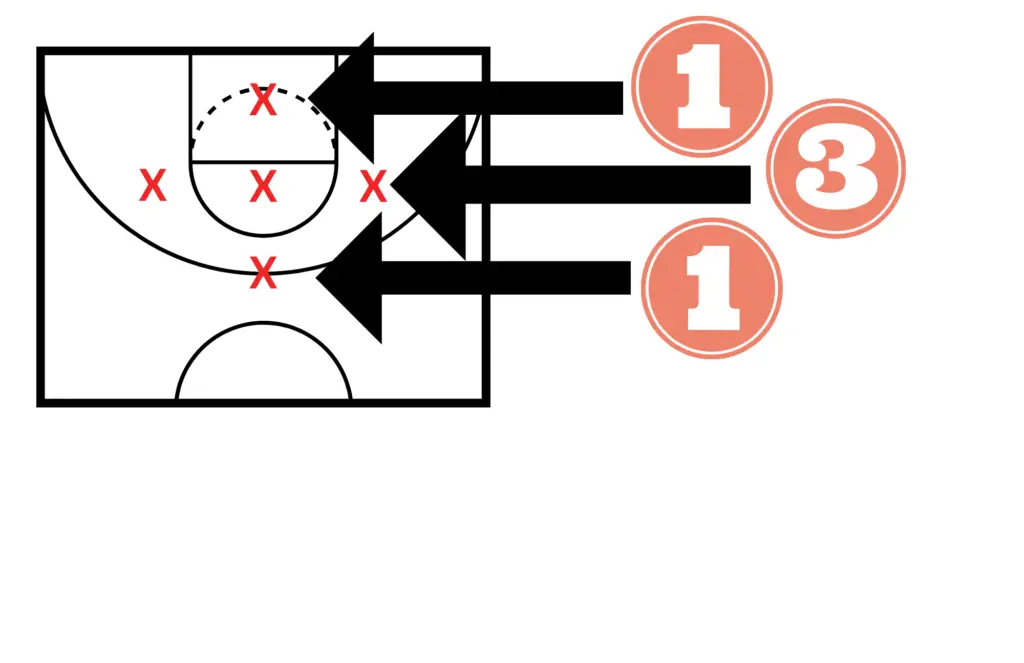
One important detail to remember. Always refer to the number sequence as you are looking at the defense from the half court line. For example, the front or top is the three point line and the basket is the back.
Simple right?
How to Setup the 1-3-1 Zone Defense:
Formation:
The 1-3-1 zone defense formation is setup with a guard at the top and three players in the middle and a center protecting the rim. See the example below:
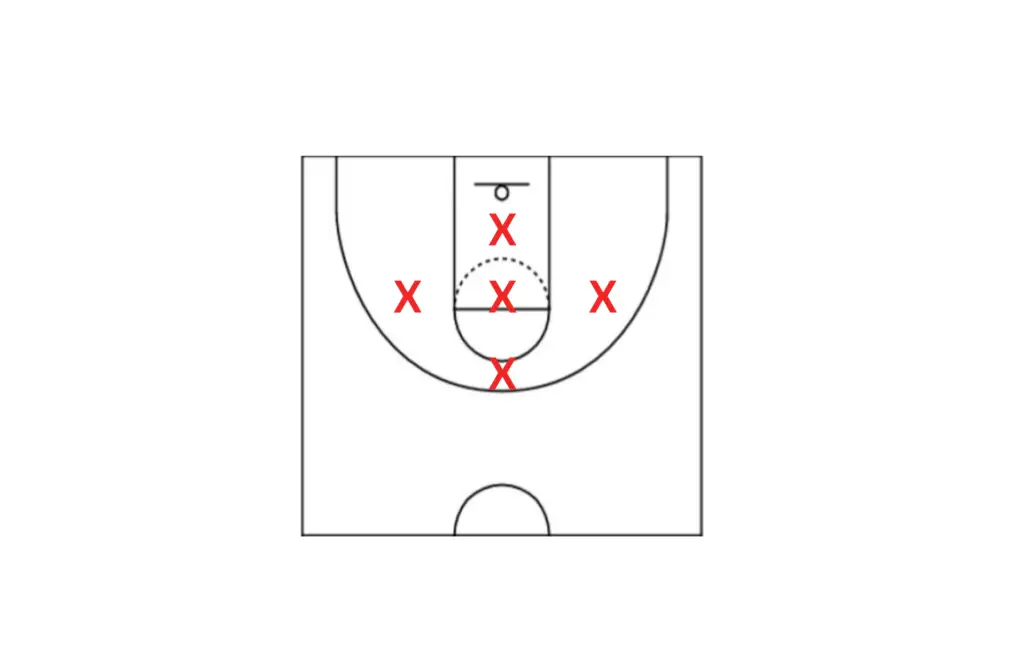
Setup:
The 1-3-1 zone defense can be extended to cover more area and create increased pressure. The three ways you can setup the 1-3-1 zone defense is:
- Three point line extended
- Half court
- Full court
I will focus on the basic setup of the 1-3-1 zone for this article.
Player Selection for the 1-3-1 Zone Defense:
The best personnel for this type of defense are athletic and long players. Players who are good at anticipating passes to create a deflection. Players that are disciplined enough to stay in the passing lane and avoid the temptation of jumping on an offensive player. Players that have a strong basketball IQ and know when and how to stunt and force a dead ball situation.
Roles and Responsibilities for Each Player (in the 1-3-1 Zone Defense):
Here is the breakdown of players you will need:
Top Player
As mentioned in this beginning of this article. The objective of the 1 3 1 zone defense is to keep the ball on one side of the court. This all starts with the top player in the zone.
Select a player that is athletic but has good basketball IQ. This player should understand the strategy.
They should also be able to move quickly to deflect passes.
Most of the time this can be your point guard. But, it can also be a power forward. It really depends on what you are working with.
Three Middle Players
The 1-3-1 zone defense has three players in the middle of the zone. These three players are not equal. You want your tall center to be in the middle of these three players.
The two players on the outside are your wing defenders.
The Bottom Player:
Select a player that is quick and can move fast. This player will need to sprint from baseline to baseline.
How the 1-3-1 Zone Defense Works:
Quick Note: All players should try to push the ball to one side of the court and keep it there!
How it all Begins:
The top player will attack the offense by forcing the ball handler to one side of the court as shown in diagram one below. This will be done by picking up the player and guarding him or her in a manner that discourages the dribbler from coming down the middle of the court.
The top defender can stint forward to put pressure on the player. But he must not get too close. He needs to maintain enough room to react.
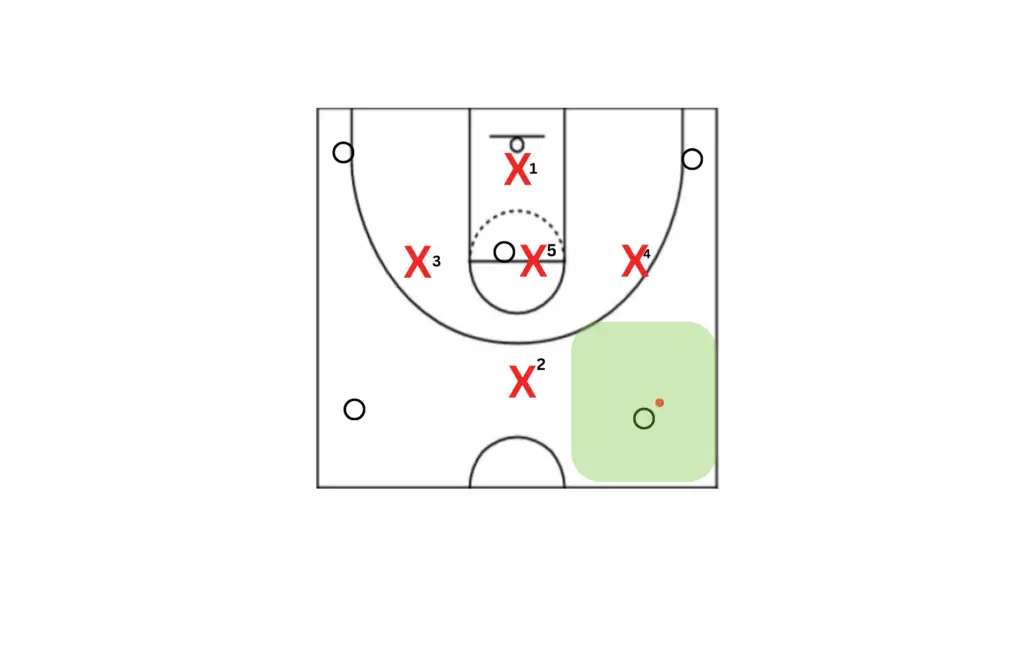
Ball Passed to the Wing:
The only real option for the offense is to pass the ball to the wing. Once this happens, the defense should make the following rotations:
X1 quickly moves to the corner and provides pressure on the offensive player in the corner.
X5 moves down to the rim to provide coverage on the low post.
X2 covers the high post and assists X3 protect the paint just in case the offensive player attempts to penetrate with a dribble.
Now remember how I talked about keeping the ball on one side of the court?
This is why the other side of the court is RED in the diagram below. The offense will try to reverse the ball and take advantage of the defensive rotations. There will be gaps in the defense if the ball is rotated.
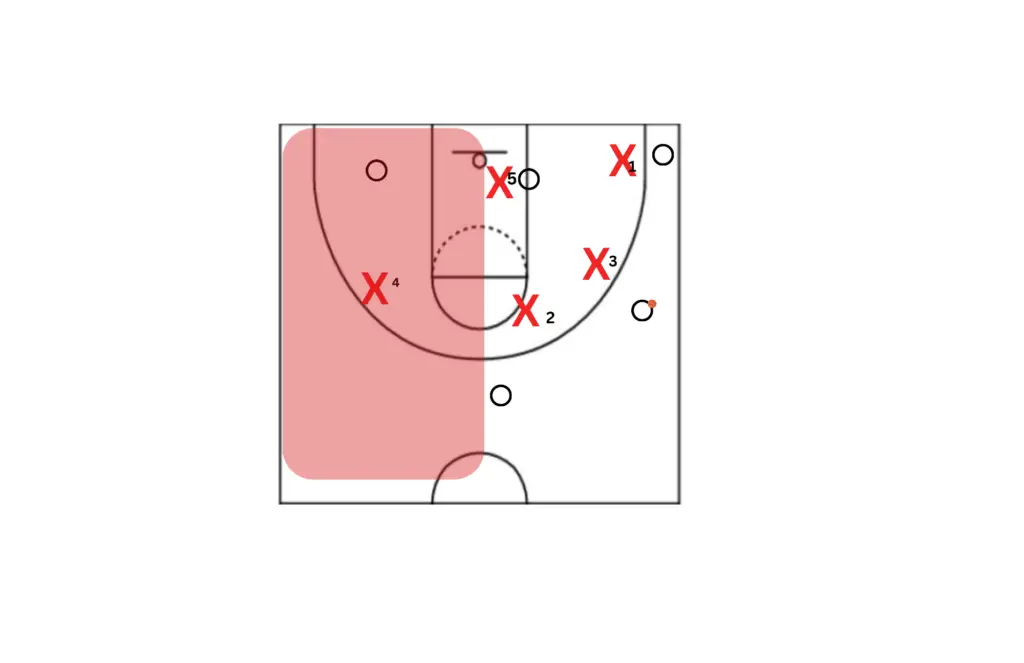
Offensive Options:
The wing player has three options.
Option 1, is to pass the ball to the close corner.
Option 2, is to penetrate.
Option 3, is a lob pass to the far corner.
The ball handler will try to make a decision here. He will go for one of the three options we talked about above (pass to corner, pass to top, or lob pass to far corner).
Here is what the defense should be PREPARED to do:
- X2 must be ready to dart forward to intercept or deflect any passes to the top of the key. In the diagram below, you will see an arrow depicting X2 moving forward to intercept/deflect passes from wing to the top of the key. This is why the 1-3-1 zone defense is so much fun!
- X4 must also be ready to react to any lob passes!
- X1 can either encourage a pass to the corner or not.
If the ball gets to the corner X1 and X3 can setup an effective trap and force a turnover. Good things often happen to the defense when the ball is in the corner.
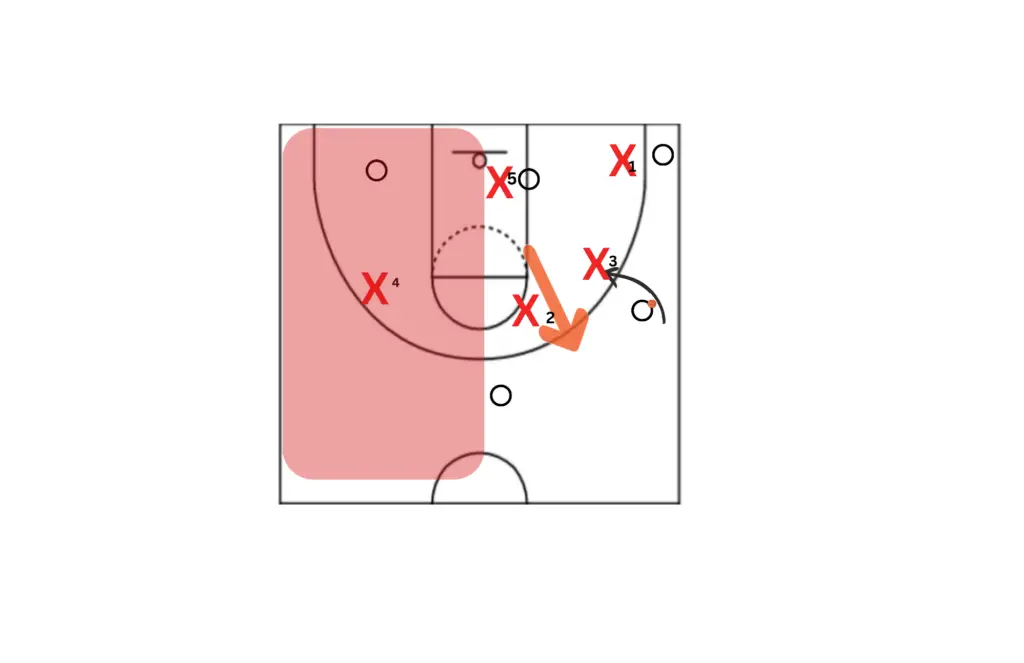
Ball to Corner:
If the ball gets into the corner but a trap doesn’t work. The ball will either be passed to the low post player or back to the wing.
Ball to Low Post:
This is a vulnerable area for this defense.
X5 will have to play defense if the ball gets to the low post. X1 will move from the corner to the low post to assist.
X1 must be prepared to quickly closeout if the ball is passed to the corner.
Ball to the High Post:
Ok, as mentioned above. The top defender should always avoid allowing the ball handler to dribble the ball down the middle.
The same is true for the high post. The defense should avoid allowing the ball to get to the high post. As a coach on offense, I always want the ball in the high post – it’s easier to score and pass to any spot on the court. As a coach on defense, I never want the ball in the high post!
First, X5 should make it very difficult to get the ball into the high post.
There are two actions that must happen when running the 1-3-1 zone defense and the ball gets into the high post. Here they are:
- X5 should immediately pressure the high post player with the help of X2.
- Cover the low post area with X1 and the weak side wing. They both should close in to discourage any easy layups from the high post player.
If you are looking for a DVD to learn more about how to coach the 1-3-1 zone defense you should check out the Aggressive 1-3-1 Zone Defense video by Coach Tom Blackford.
Conclusion:
In this article we discussed the 1 3 1 zone defense strategy used in coaching basketball teams. We dived into subjects such as the setup and formation of the 1 3 1 zone defense. We talk about whey and when to use this type of defense and how players are selected and their individual roles and responsibilities.
